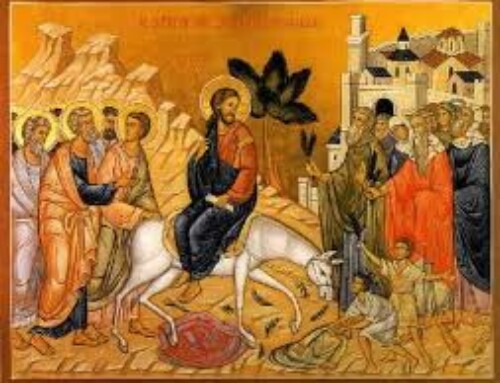Word Magazine October 1975 Page 12-13
THE AKATHIST HYMN
By EMMY P. KARAVELLAS
I
The Akathist Hymn is an extensive lyric poem of unparalleled beauty, dedicated to the Virgin Mary. Chanted on the first five successive Fridays of the Lent period of the Eastern Orthodox Church, it has a unique quality of attracting thousands of faithful worshipers to the houses of God. A controversy, still unresolved, surrounds the origin and authorship of this wonderful Hymn. According to some critics, it was first chanted in the thanksgiving services following the victory of the Byzantine people of Constantinople over the Moslems and the Persians of King Hosroes on August 8, of the year 626. This was the first time that the city itself was besieged. At the absence of Emperor Herakleios, who was fighting the Persians in the depths of Asia, the spiritual leader of the people, Patriarch Sergius, in a moment of exaltation, led the clergy to the walls of the city and with Holy Icons and prayers encouraged the defenders to fight for the ideals of their faith and their country. After a long struggle the outnumbered people of Constantinople succeeded in pushing back the enemy and raising the siege of the city. Immediately following the victory, the people, as an expression of deep gratitude, thronged the Church of the Virgin Mary in Vlahernae and sang the Akathist Hymn while standing up during the whole night. For this reason the service is called “The Akathist” from the Greek word
— to sit — and the negative prefix a, without sitting. The Service was devoted to the Virgin Mary, “The Invisible Champion”, to whom the people gave praise and thanks. Since the word Xaipe (Haire) —Hail——is continually repeated throughout the poem, the Hymn came to be called Xaipetiguoi (Hairetismi) — Salutations or Greetings.
According to another group of scholars, the Hymn is the product of other besieges of Constantinople that took place on later dates: at 860 by the Russians, 820 by the Slovaks, at 671 and 717-718 by the Moslems. Still others relate it to the “Revolt of Nicas” in 539. Most of the scholars, however, place the Hymn on the victory of August 626 against the Persians. And since Patriarch Sergios’ name is closely associated with it, many researchers believe that he was the author of the Hymn. The fact that the Akathist is so skillfully written, however, excludes the possibility of its composition on the spur of the moment for such an occasion as a thanksgiving service.
A third group of scholars tend to conclude that the Akathist is the great achievement of Romanos the Melodios. There is a definite documentary manuscript of the thirteenth century pointing to the effect that this Hymn was written during the peak of ecclesiastical hymnody (namely the fifth or sixth century), and that the poet was either Patriarch Sergios or Romanos. A close and careful study of the Hymn and its high literary merit would indicate that Romanos the Melodios, the best of the Byzantine hymnodists, was the author of this masterpiece, which has very justly been called by many “the precious stone that adorns Christian poetry”. Because of its beauty and literary value, this work is the only hymn that was admitted in its entirety in the Orthodox Church. As Costis Palamas—one of the leading contemporary Greek poets—said, “the poem is a perfect mosaic made by pieces of all kinds of colorful stones collected from everywhere — an achievement both dogmatic and triumphant at the same time—.” In fact, the Akathist is a harmonious poetic composition with balanced structure between content and form.
It consists of the prelude “Te Hypermacho”, a poem in itself, praising the Virgin Mary for her assistance in the victory against the enemy, and the twenty-four stanzas called “Oikoi”. The poem is achrostichly arranged, the stanzas of which are starting with the first letter of the Greek alphabet, Alpha, and concluding with the last one, Omega. Eleven out of the twenty-four stanzas are short; written in prose, they end with the world “Alleluia”. The remaining thirteen are long, made up of rhythmic and modal poetic verses and conclude with “Xaipe vuygn avuguevte” (Haire Nimfi animfefte)—Hail ever—Virgin and Bride. Divided into four parts with six letters of the Greek alphabet corresponding to each part, the poem is chanted the first four Fridays of Lent and is repeated in its totality on the fifth Friday.
The first part deals with the Annunciation of the Virgin Mary by the Angel. It describes Mary’s surprise at the news, her visit to her mother and Joseph’s doubts as to her innocence.
The second part is about the birth of Christ, the worship of the Shepherds and Magi, the flight to Egypt and the visit to St. Simeon in the Temple. In the third part the poet talks to the people pointing out the renewal of the world by Christ’s coming, and the amazement of the Angels and the wise men at the sight of the Incarnation of God’s Son. The fourth and the last part is once more a lyric and rhetorical appraisal of Virgin Mary, whom the poet adorns with the most beautiful of adjectives asking her to accept his poetical offering and to intercede for the salvation of human race from the earthly sin.
Although the Akathist is a strictly Orthodox Service that originated in a historical fact of ethnic interest, it has been highly honored by other Christian faiths, and it has been metrically translated by outstanding poets in English, Latin, German, Russian, Rumanian, Arabic, French, Italian, Spanish and other languages. The great appeal of the work is mainly due to the lyric quality of the composition as well as the simplicity of the plot: the happy mystery of the Incarnation of Logos of God. It relates to man’s need to glorify and praise what is sacred and especially the Incarnation of the Lord through Virgin Mary. This high tendency of Man to incarnate the supernatural and immaterialize what is material gives the tragic man a sense of deliverance which he yearns for.
Year after year, the same old people crowd the Orthodox Churches to listen to this wonderful service that has the power to bring human beings closer to their Creator and whose music, rhyme and meter cause a spiritual euphoria. Most of these people have memorized the whole service which in turn is to be passed on to future generations in a manner of folklore tradition. For the Orthodox Christian, Virgin Mary is “the
holiest human being that has reached the highest degree of perfection ever attained by anyone”. She is the one that people trust to intercede for their forgiveness and salvation. She is a mother, and for this reason women especially feel closer to her:
“Hail vessel of rejoicing”
“Hail the shining throne of the Almighty”
“Hail heavenly ladder by whom God has descended”
“Hail bridge carrying the earthborn to Heaven”.
She is the one who is guiding us from heaven, as the poet says, and the faithful recite:
“Hail pillar of light guiding those in darkness.
Hail shelter of the world broader than a cloud.”
“Hail thou land of promise,
Hail source of milk and honey outpouring
Hail Ever — Virgin and Bride.”
“Hail Tabernacle of God the Logos.
Hail! Surpassing all Saints in holiness
Hail! Ark made golden by the Holy Spirit . . .“
In conclusion, the Akathist is a literary and ecclesiastic monument erected by man during a moment of fear and inspiration for the purpose of exalting his faith and expressing his gratitude to an image whom he considers “The shining throne of the Almighty” and “the table loaded with blessings, the meadow producing contentment.” By this token man indirectly gives also thanks to his Creator for having endowed him with the great power of Logos in order to express his inner thoughts and praise the Mother of the real and true Logos.
This paper was presented by Emmy Karavellas in an English class for the study of The Bible as Literature, taught by Dr. Eugene Etheridge at Indiana State University in Terre Haute, Indiana.
Bibliography
Sources of General Information
Kokkinakis, Athinagoras. The Akathist Hymn (Greek Archdiocese of North and South America, 1954)
Pandellakis, E. Greek Encyclopaedia Pyrsos, Vol. 3
Tomadakis, A. Greek Encyclopaedia Helios (Athens, 1938)
Xides, Theodoros. “The Akathist” Aktines, (Athens, 1947)



